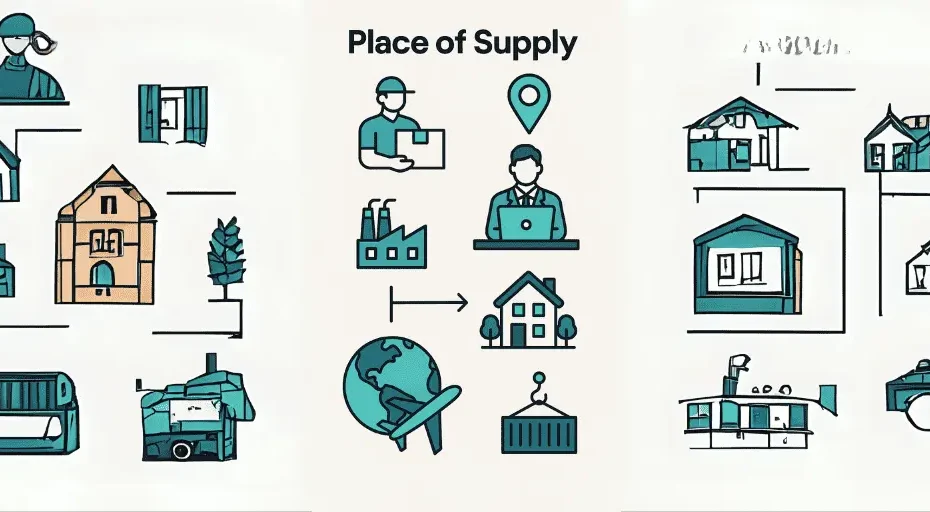Place of Supply Rules Under GST: Advanced Scenarios & Case Studies
The Goods and Services Tax (GST) regime in India introduced a unified tax structure across the country, replacing the complex web of indirect taxes. One of the most critical components of this regime is the place of supply under GST. Determining the correct place of supply is essential for identifying whether a transaction is intra-state (attracting CGST and SGST) or inter-state (attracting IGST). While the basic rules are fairly straightforward, complexities arise in advanced or exceptional cases.
In this blog, we explore the place of supply under GST through advanced scenarios and real-world case studies, enabling taxpayers to better understand their obligations and ensure full compliance.
What is the Place of Supply Under GST?
The place of supply under GST refers to the location where a transaction is deemed to occur for taxation purposes. It is essential for determining whether CGST/SGST or IGST applies. The rules differ for goods and services, and also vary based on whether the transaction is domestic or involves imports/exports.
For goods, the place of supply generally depends on the location of the delivery. For services, it can vary widely depending on the nature of the service.
Why is Place of Supply Important?
Tax Jurisdiction: The correct tax (CGST, SGST, or IGST) is applied based on the place of supply.
Revenue Distribution: It ensures fair allocation of revenue between states and the Centre.
Compliance and Input Tax Credit (ITC): Incorrect classification can lead to denial of ITC and penalties.
Understanding the place of supply under GST is therefore not just a legal requirement but also a strategic necessity for businesses.
Basic Rules Recap
For Goods:
Within India: Location of delivery is the place of supply.
Outside India: Place of supply is the location of the recipient.
For Services:
B2B Transactions: Place of supply is usually the location of the recipient.
B2C Transactions: Place of supply is typically the location of the supplier unless specific rules apply.
Advanced Scenarios for Place of Supply Under GST
Let’s now delve into complex use-cases where the place of supply under GST might not be immediately apparent.
1: Installation of Goods at a Site
Example: A Mumbai-based supplier delivers and installs industrial equipment at a client’s factory in Gujarat.
Place of Supply: Gujarat (location of installation)
Type of Supply: Inter-state
Applicable Tax: IGST
Here, although the supplier is in Maharashtra, since the installation occurs in Gujarat, that’s considered the place of supply under GST.
2: Event Management Services
Example: An event management company based in Bengaluru provides services for a wedding held in Udaipur.
Place of Supply: Udaipur, Rajasthan (location of event)
Type of Supply: Inter-state
Applicable Tax: IGST
Event-based services are taxed based on the location of the event, not the recipient or service provider.
3: Cross-Border Service with Indian Billing
Example: A Pune-based consultancy firm provides services to a client in the U.S., but the billing is done to an Indian branch of the client.
Place of Supply: India (location of the billed recipient)
Type of Supply: Intra-state or Inter-state depending on the Indian recipient’s location
Applicable Tax: GST applicable as it is not an export
In this case, despite the service benefiting a foreign client, the place of supply under GST becomes India due to the billing arrangement.
4: Transportation of Goods Across States
Example: A transporter moves goods from Delhi to Mumbai for a buyer based in Chennai.
Place of Supply: Chennai (location of the recipient)
Type of Supply: Inter-state
Applicable Tax: IGST
For transportation services, the place of supply is generally the location of the recipient.
5: Training Services at Multiple Locations
Example: A training provider from Hyderabad delivers programs in both Kolkata and Bengaluru under one contract.
Place of Supply: Locations where training is conducted
Type of Supply: Multiple supplies, each treated independently
Applicable Tax: IGST or CGST+SGST based on each location
This is a classic case where identifying the correct place of supply under GST is vital for accurate billing and compliance.
International Transactions and Place of Supply Under GST
In case of exports and imports, special rules apply:
Exports of Services:
Place of supply is outside India
No GST if conditions are met (export treated as zero-rated supply)
Imports of Services:
Place of supply is India
IGST payable under reverse charge mechanism
Understanding how the place of supply under GST functions in global trade is crucial for service providers and importers.
Case Study: Software-as-a-Service (SaaS) Company
Background: A Noida-based SaaS firm provides cloud-based software to clients across India and internationally.
Domestic Clients: IGST or CGST/SGST depending on client location
Overseas Clients: No GST if payment is received in foreign currency and other export conditions are met
Here, determining the place of supply under GST is central to claiming zero-rated benefits and availing input tax credit properly.
Key Challenges in Determining Place of Supply Under GST
Multiple service locations
Mixed contracts involving goods and services
Billing to one location, service delivery to another
Third-party arrangements
Incorrect GST code mapping
In all these cases, taxpayers must analyze each component of a transaction to apply the correct place of supply under GST rules.
Tips for Compliance
Maintain proper documentation such as contracts, invoices, delivery notes, and service agreements.
Use GST-compliant software to automate place of supply identification.
Train your accounting and legal teams on complex GST scenarios.
Seek advance rulings where ambiguities exist.
Mistakes in determining the correct place of supply under GST can lead to penalties, denial of ITC, and unnecessary litigation.
Conclusion
The place of supply under GST is more than just a regulatory detail—it’s a critical factor in determining tax liability, ensuring compliance, and managing cash flow. As businesses grow and transactions become more complex, understanding special cases becomes essential.
Our GST Services

All E-commerce Tax services
E-commerce tax services help online sellers navigate GST registration, compliance, return filing, TCS management, tax planning, and audits, ensuring efficient tax management and legal compliance.

GST Filing
GST filing is the process of submitting tax returns to the government, detailing sales, purchases, and taxes paid or collected, ensuring compliance with GST laws.

GST Registration
GST registration is the process where businesses obtain a GSTIN from the government, allowing them to collect taxes, claim input tax credits, and comply with GST laws.






I would like to thank you for the efforts you’ve put in penning this site.
I am hoping to see the same high-grade blog posts by
you in the future as well. In fact, your creative writing abilities has inspired me
to get my own site now ;)